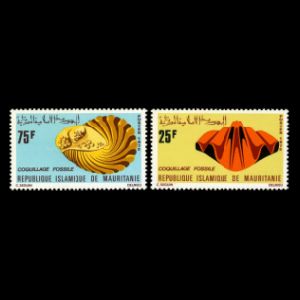the place where Paleontology and Paleoanthropology meets Philately
Mauritania
Fossils on stamps of Mauritania
| << previous country | back to index | next country >> |
Contents:
- Country overview
- Philately of Mauritania
- Official stamps of Mauritania related to Paleontology
- References
- Acknowledgements
Mauritania, officially the Islamic Republic of Mauritania, is a country in the Maghreb region of western North Africa. It is ordered by the Atlantic Ocean to the west, Morocco and the remnants of Western Sahara in the north, Algeria in the northeast, Mali in the east and southeast, and Senegal in the southwest.
The capital and largest city is Nouakchott, located on the Atlantic coast, which is home to around one-third of the country's 3.5 million people.
It was a constituent part of French West Africa from the mid-19th Century until it achieved independence in 1960. [R1]
The first stamps of independent Mauritania were issued on January 20, 1960. Since independence, Mauritania has issued a moderate number of colorful stamps, usually in denominations intended for normal postal purposes.
Topics range widely, from internationally renowned personages, international organizations, wildlife and marine animals, sports, aviation, etc.
The French African CFA franc was in use until 1973, when a new currency, the ougouya (UM) was introduced at a rate of 1 UM = 5 fr. CFA, resulting in stamp issues in the new currency.
Some stamps are surcharged after currency change. [R2]
Official stamps of Mauritania related to Paleontology: fossils
| 31.07.1972 "Fossil Shells" [1] | 28.01.1974 Surcharged on previous issues | |
 |
 |
|
Notes:
[1] None of these animals are shells: rolled Trilobite, is shown on the blue stamp and brachiopod is shown on the yellow one.

Other stamps of Mauritania to consider
| 14.10.1986 "Halley's Comet" [O1] | ||
 |
|
|
Notes:
[O1] The stamps from the set issued in sheets and Souvenir Blocks.
 One of these blocks shows astronomer William Huggins (1824-1910) on the stamp, who was an English astronomer
best known for his pioneering work in astronomical spectroscopy together with his wife Margaret Lindsay Huggins.
One of these blocks shows astronomer William Huggins (1824-1910) on the stamp, who was an English astronomer
best known for his pioneering work in astronomical spectroscopy together with his wife Margaret Lindsay Huggins.Another object on the stamp is Ariane rocket. This rocket launched Giotto spacecraft on July 2nd 1985. The purpose of the Giotto mission was to study Comet Halley during the comet's perihelion passage in 1986.
Several prehistoric animals are on the margin of the block. The French text on the margin should explain it: 'La disparition des dinosaures il y a 65 million d'annees' that means Disappearance of the dinosaurs 65 million years ago.
To be correct, there are only two dinosaurs among four prehistoric animals that are depicted there, two others are flying reptiles that called pterosaurs. Moreover, all these prehistoric animals, dinosaurs Iguanodon and a big Sauropod dinosaur, perhaps Diplodocus as well as pterosaurs Pteranodon and Rhamphorhynchus disappeared from the Earth many tens million years before an asteroid killed 70% of all living animals 65 million years ago.
References:
- [R1] Mauritania: Wikipedia, WikiTravel, FlagCounter.
- [R2] Postal History and Philately of Mauritania:
Wikipedia,
Links to official website of the Post Authority, stamp catalog and a list of new stamps of Mauritania are here. - [R3] Giotto: NASA
Acknowledgements:
Many thanks to Dr. Peter Voice from Department of Geological and Environmental Sciences, Western Michigan University, for the draft page review and his valuable comments.
| << previous country | back to index | next country >> |